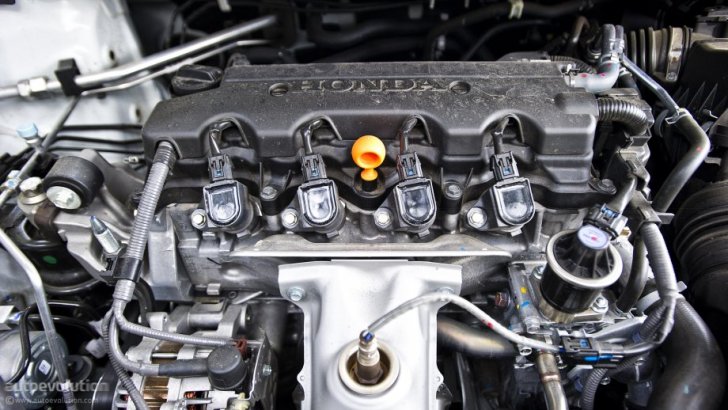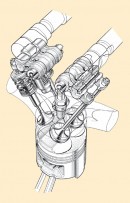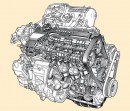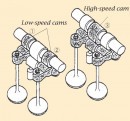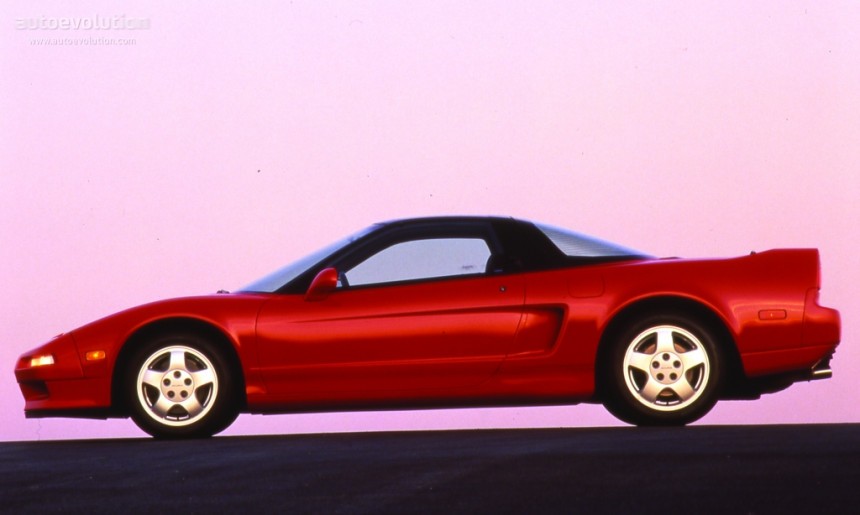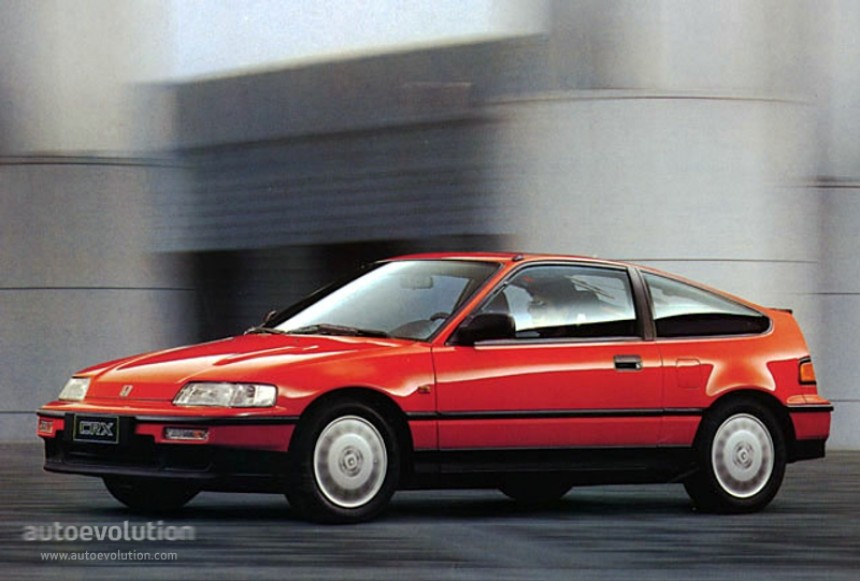Honda’s VTEC system is almost as famous as the brand itself. It is steeped in many myths from motorsport, street racing, motorbikes, and even supercars. VTEC is found in any Civic Type R, the screaming S2000, and, obviously, the mighty NSX. But what exactly is this system?
VTEC stands for Variable Valve Timing and Lift Electronic Control. Honda developed this variable valvetrain system to offer efficiency and power in smaller engines. VTEC systems use two camshaft profiles, one for improved fuel efficiency and another for high-end performance. This kind of system is also used by other carmakers, but under different names: VANOS for BMW, VVT-i for Toyota, or Camtronic for Mercedes-Benz.
The VTEC engine's story starts in the 80s when it was developed and fitted on the 1983 CBR400 motorcycle. But the Japanese brand tried to implement it in its car range, such as the Civic or the Accord. After the 1979 Oil Crisis, low fuel consumption became critical for many customers. That's why the Japanese automaker's Tochigi R&D Center started to create a "dream engine." That had to be both powerful and fuel efficient.
Developing an engine with high specific output but low fuel consumption was considered a key element in Honda's success in the global market. Yet, the problem with naturally aspirated engines was that it wasn't possible to adjust the fuel-air quantity per stroke. So, for stronger performance, more was needed. But, at the same time, less was required for increased fuel efficiency.
The air quantity per stroke was mechanically controlled by the intake's valve diameter and the cam height. Ikuo Kajitani, who's believed to be the father of the VTEC engine, worked at that time in the First Design Department at the Tochigi Center. He understood that he could not control the valve's diameter, so he envisioned a solution to alter the valve operations depending on the engine speed. His idea was followed, and finally, the VTEC engine was born.
At that time, Honda already had a 130 ps, 1.6-liter engine on the market. It featured a double overhead camshaft (DOHC) system and was praised for its qualities. However, Kajitani understood that if he showed up with a 140 ps version for the same powerplant, it wouldn't please Honda's R&D Center boss Nabuhiko Kawamoto. As a result, they agreed with the specific objective of 100 ps/liter.
But Kajitani's effort was not in vain. In 1989, his ideas found their way onto the new Honda Integra, which featured a DOHC/VTEC system that helped the little 1.6-liter mill to produce 160 hp. Moreover, the new powerplant featured fewer vibrations and smoother idling. As a result, the first variable valve-timing system was praised worldwide.
In the following year, Honda introduced the sporty CR-X model, which stood for "Civic Renaissance model X," fitted with the famous B16A engine. This unit was rated at 150 PS for the European market, while the JDM version, sporting the SiR nameplate, provided 160 ponies at a stratospheric 8000 revolutions per minute.
Kajitai, later on, said, "It felt like a dream. Conventional engines in those days could only produce 70 or 80 horsepower per liter. But here we were, being asked to increase it all the way to 100 horses. It wasn't going to be easy."
His team faced many difficulties when it designed the B16A, as the reliability factor had to be taken into account. After all, the maximum rev-limit exceeded most other powerplants on the market by 20%. In addition, it had to withstand 40% bigger forces.
For that, the engine was fitted with new high-density, high-strength sintered alloy pulleys that reduced the inertial load on the timing belt. In addition, Honda increased the intake valves' diameters from 30 to 33 mm.
But the engine had to develop enough torque in low and mid-range revs. That led to a different timing for the low-speed cams, which was changed to 20/30 degrees ABDC (after bottom-dead-center) from 35 degrees. Or to close the valves earlier than before, to put it simply.
But placing three cams followers in the same space was challenging. To solve this problem, Honda used a new high-carbon, high-chrome cast alloy steel that was stronger than the alloys used on regular camshafts. In addition, the exhaust cams were made from a nickel-based alloy that was heat-resistant.
Honda tried these new VTEC engines on its home market before exporting them to Europe. The carmaker had to be sure that this new system would work flawlessly before sending it to the U.S. market. Thus, the first VTEC engine sold on the American market was the NSX (New Sportscar eXperimental). This was the first supercar with family-car reliability. Its 3.0-liter V6 DOHC VTEC powerplant produced 270-PS. At the same time, Honda also developed new variable valve timing engines for its 1.8-, 2.0-, and 2.2-liter inline-four engines.
Thanks to its revolutionary solution, Honda's popularity went through the roof, and the VTEC acronym became a powerful marketing tool. Yet, the carmaker understood that it could use this idea also for the single overhead camshaft systems (SHOC) and control only the intake valves. The V6 3.7-liter J37A4 engine, for instance, featured another improvement for the rockers' shape that allowed it to push two intake valves at once.
Honda's focus on reliability was also proven: none of the first one million VTEC systems failed. Moreover, the automaker continued the development in the direction of fuel efficiency, adding a new technology named VCM (Variable Cylinder Management), which is a form of cylinder deactivation, and a computer-controlled variable cam timing named i-VTEC.
The VTEC engine's story starts in the 80s when it was developed and fitted on the 1983 CBR400 motorcycle. But the Japanese brand tried to implement it in its car range, such as the Civic or the Accord. After the 1979 Oil Crisis, low fuel consumption became critical for many customers. That's why the Japanese automaker's Tochigi R&D Center started to create a "dream engine." That had to be both powerful and fuel efficient.
Developing an engine with high specific output but low fuel consumption was considered a key element in Honda's success in the global market. Yet, the problem with naturally aspirated engines was that it wasn't possible to adjust the fuel-air quantity per stroke. So, for stronger performance, more was needed. But, at the same time, less was required for increased fuel efficiency.
At that time, Honda already had a 130 ps, 1.6-liter engine on the market. It featured a double overhead camshaft (DOHC) system and was praised for its qualities. However, Kajitani understood that if he showed up with a 140 ps version for the same powerplant, it wouldn't please Honda's R&D Center boss Nabuhiko Kawamoto. As a result, they agreed with the specific objective of 100 ps/liter.
But Kajitani's effort was not in vain. In 1989, his ideas found their way onto the new Honda Integra, which featured a DOHC/VTEC system that helped the little 1.6-liter mill to produce 160 hp. Moreover, the new powerplant featured fewer vibrations and smoother idling. As a result, the first variable valve-timing system was praised worldwide.
Kajitai, later on, said, "It felt like a dream. Conventional engines in those days could only produce 70 or 80 horsepower per liter. But here we were, being asked to increase it all the way to 100 horses. It wasn't going to be easy."
His team faced many difficulties when it designed the B16A, as the reliability factor had to be taken into account. After all, the maximum rev-limit exceeded most other powerplants on the market by 20%. In addition, it had to withstand 40% bigger forces.
For that, the engine was fitted with new high-density, high-strength sintered alloy pulleys that reduced the inertial load on the timing belt. In addition, Honda increased the intake valves' diameters from 30 to 33 mm.
But placing three cams followers in the same space was challenging. To solve this problem, Honda used a new high-carbon, high-chrome cast alloy steel that was stronger than the alloys used on regular camshafts. In addition, the exhaust cams were made from a nickel-based alloy that was heat-resistant.
Honda tried these new VTEC engines on its home market before exporting them to Europe. The carmaker had to be sure that this new system would work flawlessly before sending it to the U.S. market. Thus, the first VTEC engine sold on the American market was the NSX (New Sportscar eXperimental). This was the first supercar with family-car reliability. Its 3.0-liter V6 DOHC VTEC powerplant produced 270-PS. At the same time, Honda also developed new variable valve timing engines for its 1.8-, 2.0-, and 2.2-liter inline-four engines.
Thanks to its revolutionary solution, Honda's popularity went through the roof, and the VTEC acronym became a powerful marketing tool. Yet, the carmaker understood that it could use this idea also for the single overhead camshaft systems (SHOC) and control only the intake valves. The V6 3.7-liter J37A4 engine, for instance, featured another improvement for the rockers' shape that allowed it to push two intake valves at once.
Honda's focus on reliability was also proven: none of the first one million VTEC systems failed. Moreover, the automaker continued the development in the direction of fuel efficiency, adding a new technology named VCM (Variable Cylinder Management), which is a form of cylinder deactivation, and a computer-controlled variable cam timing named i-VTEC.
